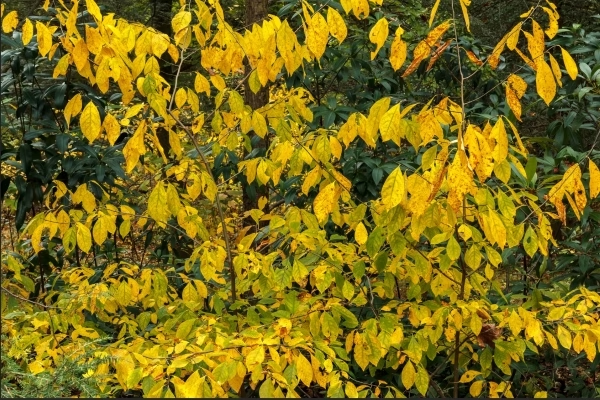
Northern Spicebush
Botanical Name
:
Lindera benzoin
Plant Type
:
Deciduous shrub
Seasons
:
Plant in spring or fall; blooms in spring
Sun Level
:
Pefers partial shade to full shade. It will grow in full sun, but it can struggle, especially in hotter climates
Ideal Soil Temperature for Planting
:
50–70°F (10–21°C)
Soil Type
:
Moist, well-drained soil; loamy
Hardiness Zones
:
4–9 (USDA)
Germination
:
2–3 months
P.H. Level
:
Acid to alkaline soil (pH 5.0 to 8.0)
Water/Irrigation
:
During the first growing season, water regularly to establish a strong root system
Fertilization
:
It’s not always necessary, especially if the soil is rich in organic matter. A single application of a balanced organic fertilizer in early spring is sufficient
Habit
:
Rounded, spreading, and somewhat open growing habit
Propagation
:
Seeds and cuttings (most preferred)
Final Plant Height
:
6–5 ft
Spread
:
6–12 ft
Flowers
:
Small yellow flowers
Attracts
:
Butterflies, pollinators, beneficial insects
Uses
:
Plantings in shady locations, erosion control, ornamental garden, and hedges
Companions
:
Virginia bluebells (Mertensia virginica), bloodroot (Sanguinaria canadensis), Christmas fern (Polystichum acrostichoides), aromatic aster (Symphyotrichum oblongifolium), and American beautyberry (Callicarpa americana)
Pruning
:
Minimal pruning is needed. Prune in spring after it has finished flowering
Toxicity
:
Generally non-toxic
Pests
:
It is relatively pest-resistant
Diseases
:
It is relatively disease-resistant
Additional Info
:
It is known for its aromatic leaves and twigs, which have a spicy fragrance when crushed
Botanical Name
:
Lindera benzoin
Plant Type
:
Deciduous shrub
Seasons
:
Plant in spring or fall; blooms in spring
Sun Level
:
Pefers partial shade to full shade. It will grow in full sun, but it can struggle, especially in hotter climates
Ideal Soil Temperature for Planting
:
50–70°F (10–21°C)
Soil Type
:
Moist, well-drained soil; loamy
Hardiness Zones
:
4–9 (USDA)
Germination
:
2–3 months
P.H. Level
:
Acid to alkaline soil (pH 5.0 to 8.0)
Water/Irrigation
:
During the first growing season, water regularly to establish a strong root system
Fertilization
:
It’s not always necessary, especially if the soil is rich in organic matter. A single application of a balanced organic fertilizer in early spring is sufficient
Habit
:
Rounded, spreading, and somewhat open growing habit
Propagation
:
Seeds and cuttings (most preferred)
Final Plant Height
:
6–5 ft
Spread
:
6–12 ft
Flowers
:
Small yellow flowers
Attracts
:
Butterflies, pollinators, beneficial insects
Uses
:
Plantings in shady locations, erosion control, ornamental garden, and hedges
Companions
:
Virginia bluebells (Mertensia virginica), bloodroot (Sanguinaria canadensis), Christmas fern (Polystichum acrostichoides), aromatic aster (Symphyotrichum oblongifolium), and American beautyberry (Callicarpa americana)
Pruning
:
Minimal pruning is needed. Prune in spring after it has finished flowering
Toxicity
:
Generally non-toxic
Pests
:
It is relatively pest-resistant
Diseases
:
It is relatively disease-resistant
Additional Info
:
It is known for its aromatic leaves and twigs, which have a spicy fragrance when crushed
Written by Nondiah Khalayi – https://www.linkedin.com/in/nondiah-khalayi/

